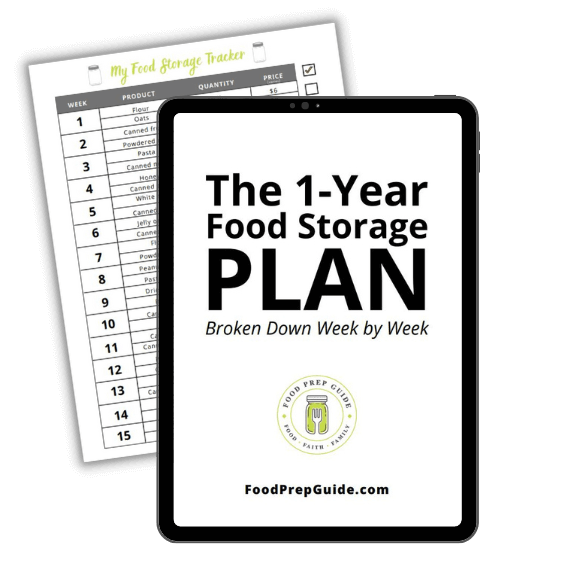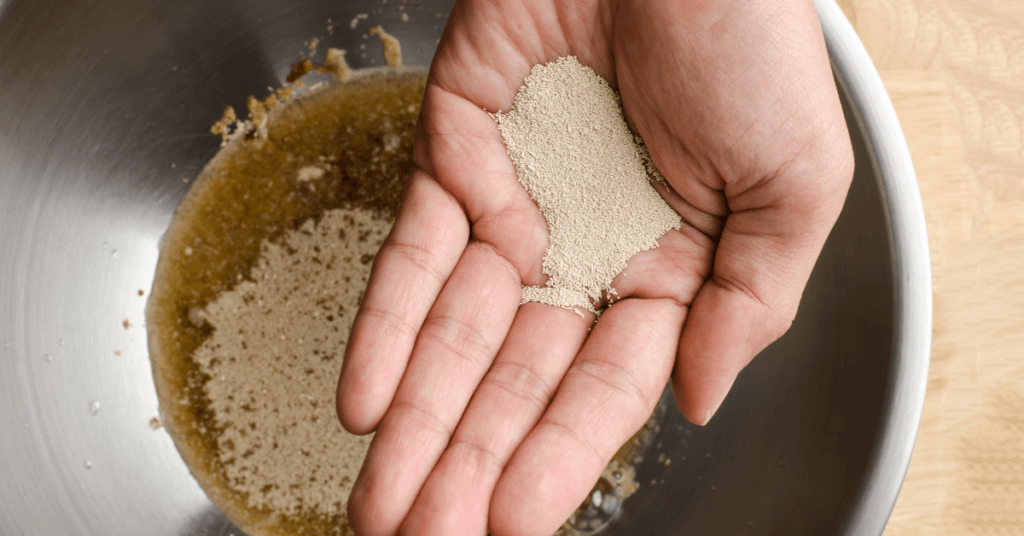Before I talk about storing yeast long-term, I want to mention fresh yeast.
Fresh yeast, used primarily by professional bakers, requires refrigeration immediately when purchased, whether opened or not.
In the refrigerator, it should remain viable for about 3 weeks if packaged properly.
Although some suggest it’s possible to freeze fresh yeast for a few months, it’s pretty much impossible to store this type of yeast long-term.
On the other hand, active dry yeast (including the instant variety) can be stored long-term with no refrigeration required.
Since active dry yeast is the type most of us are familiar with, and since we’re talking about how to store yeast long term, this article will deal with active dry yeast and instant yeast.
Side note: Instant yeast is just active dry yeast with additives to eliminate the proofing step and allow baked goods to rise twice as fast.
These additives don’t affect storage methods or longevity, so we’ll use the terms interchangeably while talking about storing yeast.
FREE FOOD STORAGE PLAN!

Does gathering and storing a year’s worth of food for your family seem overwhelming and unachievable?
Make it easy with our step-by-step plan. Subscribe to our weekly newsletter & we’ll send it to you FREE!
The Average Shelf-Life of Yeast (With No Special Preservation Techniques)
If you have very little refrigerator/freezer space or you’re equipping a cabin or other storage area that has no electrical power and, therefore, no refrigeration, it’s still possible to store yeast long-term.
The shelf life of yeast packets varies, depending on the storage method.
On average, they should last, unopened, at least 3-4 months beyond the “best by” date stamped on the packages.
This is assuming the package wasn’t exposed to heat at some point in the distribution chain, and that the original packaging is completely intact.
The “best by” date is not an expiration date. It is a date chosen by the manufacturer, usually two years post-packaging, that actually allows for less-than-optimal conditions of storage.
It should also be noted that yeast doesn’t “spoil” in a way that makes it harmful.
Instead, preparing food with yeast that’s no longer active will simply result in baked goods that don’t rise properly or at all.
Of course, non-rising yeast means wasting the other ingredients in the end product, so you’ll want to make sure your yeast is alive and potent before you begin baking.
Later in this article, we’ll talk about how to ensure your yeast is usable for your future recipes.
How to Store Yeast After Opening Its Original Packaging
What if you’ve already opened the yeast packet and need to store the remainder long-term?
The most important thing you need to do once you’ve opened the package of yeast is to immediately transfer it into an appropriate storage container:
- Vacuum-sealed bags
- Jars
- Other air-tight, moisture-resistant secondary packaging
These are all effective options for storing yeast.
Once it’s repackaged, store it as follows.
Best: Refrigerator
Most experts agree that the refrigerator is the prime storage facility for yeast, whether the yeast package has been opened or not.
This is because yeast thrives between 33- and 38-degrees Fahrenheit.
While it can remain active for years at 68 degrees, you’ll get superior results for long-term storage if you can refrigerate your yeast, particularly if it’s been opened.
Even in the fridge, though, you’ll need to take precautions.
While heat is damaging to yeast, so are moisture and exposure to the air. Refrigerators can have a high moisture content, so be sure to protect opened yeast in containers that will keep the yeast dry.
They should also be airtight, with as little extra space in the container as possible.
With these precautions, you should be able to store yeast (after opening) in the refrigerator for at least 4-6 months after first use.
To extend the life of your yeast in the fridge, it’s also preferable to use multiple small containers to store it rather than one large one.
That way, the bulk of the yeast you’re storing is not constantly in and out of the refrigerator each time you use a spoonful or two for a recipe.
How to Store Dry Yeast Long Term: Vacuum Seal It
Utilizing a vacuum sealer is an effective way to store instant yeast long term.
It works especially well if you also refrigerate the packages after sealing.
The combination of the two storage methods increases the odds of keeping the yeast alive for longer periods.
Storing Yeast in the Freezer
Another storage method is freezing, although this one is somewhat controversial.
While most yeast storage experts agree that the refrigerator is the best place to store yeast, they disagree on whether you should ever freeze yeast.
Some say long-term exposure to sub-zero temperatures will ultimately cause cellular damage, leading to less viable yeast.
However, many baking enthusiasts claim that freezing allows yeast to stay alive for many, many years.
For that reason, I’ll go ahead and talk about how to store yeast in freezer containers for the best results.
- The most effective way to freeze yeast and minimize possible damage is to use airtight containers that allow no moisture or extra air.
- Store yeast in the back of the freezer to keep temperature changes from affecting it each time you open the door.
- Since yeast is dormant while frozen, bring it to room temperature before using it. You can do this by laying it out on the counter for an hour, or more gradually, by putting it in the fridge for 30 minutes and then on the counter for an additional 30.
Storing Yeast in Mason Jars
Environmentally conscious consumers may wish to store yeast in mason jars. While this is an option, there is some concern about doing this for a couple of reasons.
First, it’s possible that light could adversely affect the yeast, which means clear glass jars may not be ideal.
Most commercial yeast jars are dark-colored, probably for this reason.
So, if you’re using jars, try to find dark jars or keep them in a darker place while storing them (back of the fridge, freezer, or cabinet).
Secondly, the “headroom” in jars, as opposed to soft-sided containers such as bags, will increase each time you use some of the yeast.
This means the yeast is exposed to more air as time goes on. Bags, on the other hand, can be rolled up to remove more air from the container.
One solution to this is to vacuum seal the mason jar as you would a vacuum-sealed bag.
Storing Yeast in Vacuum-Sealed Bags in a Cool, Dark Area
As I mentioned above, vacuum sealing is an effective option for storing yeast for long periods of time.
Although it may be somewhat difficult to seal the jar or bag without sucking up the tiny, light yeast granules, it’s worth it to eliminate air exposure.
It also helps with moisture as there’s no air in the package to transfer moisture to the granules.
If you choose not to refrigerate the yeast, you can store vacuum sealed yeast packages in a cool, dark pantry or root cellar to make it last even longer.
Always be sure to use thick, high-quality vacuum seal bags with a strong seal to avoid failure of the seal over time.
How Long Will Vacuum Sealed Yeast Last?
If you’ve purchased yeast in bulk and then re-portioned it into vacuum sealed bags, it should last almost as long as unopened packages of yeast.
Just be sure to follow all the precautions outlined above to keep out heat and moisture, storing it in the refrigerator if at all possible.
Recommended Yeast for Long-Term Storage
While budget-conscious bakers and survival preppers may prefer yeast that comes in bricks, the recommended yeast to purchase for long-term storage is that sold in smaller packets.
This is because smaller packages are “nitrogen flushed,” meaning all oxygen has been removed by the manufacturer.
Smaller packages also mean that you’re not exposing unused portions of your yeast stockpile to moisture, heat, bacteria, or other damaging factors each time you use it.
How to Keep Yeast Alive for Years (& How to Determine If It’s Dead)
Since yeast is a living organism, keeping it alive and kicking for as long as we can is our ultimate goal.
To keep yeast alive for as many years as possible, combine the storage methods outlined below:
- Buy smaller packages, if possible.
- If you’re splitting up bulk packages of yeast, vacuum seal small portions and put the bags into plastic, airtight containers or zipper bags.
- Keep as much of your yeast in the fridge as room allows.
- Some believe that the freezer is even better, although freezer space is pretty limited for most of us and there are reports of possible damage from freezing.
- Use food safety techniques and proper hygiene every time you handle opened yeast packages, and never, ever use a damp spoon to scoop out yeast from the package.
Even if you follow every precaution, your yeast may die due to factors beyond your control, such as improper manufacturer packaging, issues in the supply chain, or power outages.
This can be pretty obvious if you open a package and the yeast granules are clumpy, discolored, or moldy.
However, even long-term stored yeast that looks fine should be tested before committing expensive ingredients to its use in a recipe.
It’s easy to proof the yeast to check its viability using this method:
- Add 1 tsp of sugar to ¼ cup warm water (not hot – try for between 105- and 115-degrees Fahrenheit) and stir to combine.
- Then add 2-1/4 tsp (or one packet) of dry yeast and mix well.
- Place in a warm area and wait at least 10 minutes.
The yeast is active if it foams up to the ½ cup mark.
If it foams some but not that much, give it a few more minutes if the room is chilly.
You can also use more yeast in the recipe if the amount called for doesn’t foam enough.
If it doesn’t foam at all, it’s dead. Sorry.
FAQS
Can I store yeast in a plastic container?
Yes, you can store yeast in a plastic container. Tupperware brand and other brands that have a mechanism to remove air from the container (i.e., “burp” it) are suggested.
This helps mitigate the unchanging headroom drawback mentioned in the section about mason jar storage.
Try to find containers that are darker in color or opaque and are just large enough to hold the yeast you plan to store.
Can I freeze yeast in a jar?
Yes, if you choose to freeze yeast long-term, you can do so in a jar.
A dark-colored jar is preferred. Use the smallest one available to hold the amount of yeast you plan to freeze.
Consider other types of containers once you open and start using the yeast from the jar for the same reason as above – increased headroom as the amount of yeast is reduced.
How long can you freeze yeast?
According to some sources, yeast can be frozen and remain viable for 5 years or even more.
Some bakers have even stored yeast in the freezer for as long as 15 years.
Can you store yeast in Mylar bags?
Mylar bags are fine for storing yeast long-term.
However, don’t use mylar bags that have oxygen absorbers inside, as these can negatively affect the yeast.
The mylar can be notably beneficial when it comes to moisture protection.











